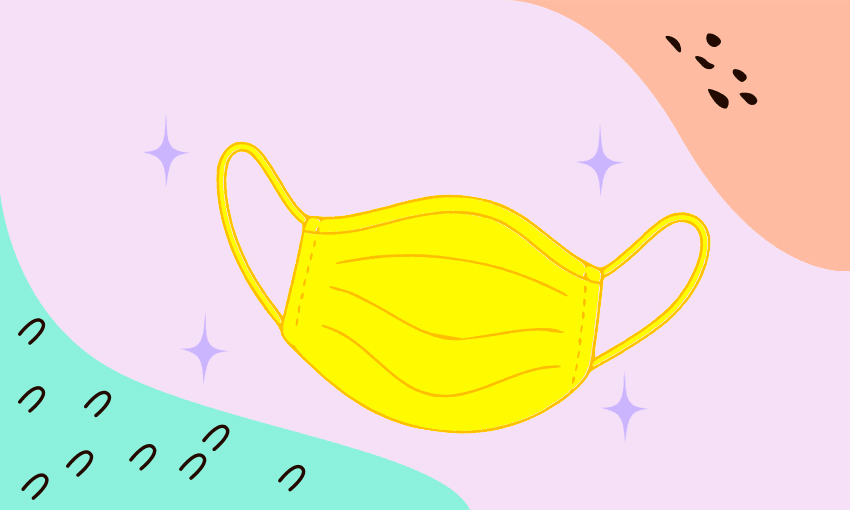Has all this increased mask wearing left your skin red, bumpy and grumpy? Alex Casey talks to esthetician Christel Chapman about how we can combat the dreaded return of mascne.
Right as the delta cluster was beginning to take shape under our very noses, there was another cluster forming right under mine. Pimples. What felt like thousands of them. Angry, rude, uninvited, and multiplying every time I removed my mask in a very sad and private magic trick. To use a dermatological phrase, my skin has turned to absolute shit in recent weeks and, based on how many people have told me their face looks “rashy” or “like leather” or just plain “disgusting”, I know I am not alone.
Of course, far more important than our rapidly erupting faces is that we all continue to wear masks whenever we leave the house to stop the spread of Covid-19. So how to do this while also protecting your rashy, leathery, angry, hell-face? I consulted with esthetician and founder of Āla Skin, Christel Chapman, for some simple solutions.
Practise acceptance
The first thing to understand is that “mascne” is a very real thing. “Pimples are most commonly caused by blocked pores that lead to congestion and then breakouts,” Chapman explains. When you wear a mask, the combination of trapped heat, product, sweat and what she describes as “your own stank breath” is likely to contribute to congestion, breakouts, redness and new and thrilling skin textures. Maybe she’s born with it? Maybe it’s mascne. Maybe she had it before masks became mandatory. She’ll never tell.
Wash your mask
It might have been rustic and alty to let your mask bake in its own filth back when we just had to wear them on buses and trains, but these days mask upkeep should be happening much more often. “Especially if you are working out in a mask, you should be washing them regularly,” says Chapman. Pop them in a little delicates bag if you’ve got one and, for the more sensitive folk, try and use a laundry powder that is hypoallergenic and doesn’t contain dyes and perfumes.
Try a different kind of mask
Now that we are getting so used to wearing masks, why stop at one kind of mask? Chapman recommends using an at-home face mask that can help to draw out impurities in the skin, most commonly being clay or mud masks. I recommend the “Youthfoil” mask, available at The Chemist Warehouse. Not detoxifying, not effective in any way, but does make you look like the Tin Man.
Wear a patch
This tip comes from The Spinoff’s own Leonie Hayden, who has found herself battling similar skin woes beneath her mask. “Once spots come up, pimple patches are the best way to heal them quickly,” she says. “You can wear them under the mask so they don’t get worse – I went to the supermarket with four patches on and no one knew, it was my special secret.” She recommends the “magical” Cos RX patches from Hikoco.
Exfoliate
Put down your terrifying St Ives apricot scrub and go for a chemical exfoliant in these trying times. “I would try to stay away from any harsh physical exfoliators containing granules or beads as they can be very irritating and can actually cause damage,” says Chapman. Instead, she recommends using products containing either salicylic or lactic acids a couple of times a week. “Chemical exfoliants sound a lot scarier and intense, but in actual fact they are far more gentle on the skin.”
Go oil-free
Even if you’ve purchased the above Tin Man mask, you want to avoid the “oil can” at all costs. “If you are experiencing a lot of breakouts under your mask I would suggest switching to an oil-free moisturiser,” says Chapman. “Sebum (oil) is a common way to cause congestion, so it is key to use a moisturiser that won’t block your pores but will still give you all the hydration you need.”
Wear sunscreen
Although it may be tempting to forgo the sometimes sticky and sweaty step of sunscreen for fear of breakouts, protecting your skin from the sun is crucial. “Even if you are working indoors, your skin is absolutely being damaged,” says Chapman. “UVA penetrates through everything from clouds to windows.” Blue light damage is also a real concern given the extra exposure we are all having to devices, so be sure to switch to night mode and incorporate an antioxidant vitamin C serum to your daily routine if you’ve got some.
Acceptance, again
The fun thing about skin is that you can do all of the above, eat right, sleep well, drink water, pay your taxes on time, and still find yourself struggling through lockdown skin stresses. “Be extra kind to yourself and your skin during this time,” says Chapman. “Remember that the skin is so wonderfully complicated and there are so many variables that come into skin behaving the way that it does.”
And you can seek solace in the fact that, even if your mascne is flaring up, nobody can see under your mask anyway.
